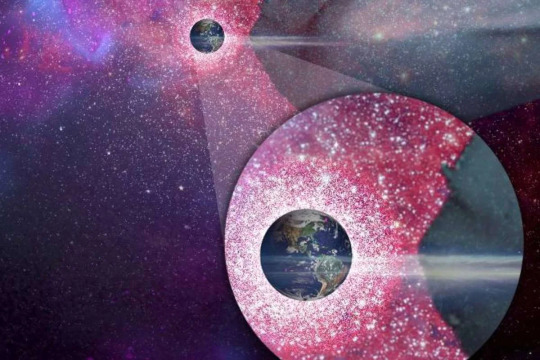#GalacticScience
Explore tagged Tumblr posts
Text

#SolarSystem#Astronomy#SpaceDiagram#CosmicJourney#CelestialBodies#PlanetarySystem#SpaceScience#PlanetaryDiagram#AstronomyLovers#SolarSystemArt#PlanetaryWonders#StellarSystem#CosmicExploration#SpaceEducation#GalacticScience#AstronomyFacts#Universe#SpaceArt#EducationalArt#CelestialVibes#PlanetArt#CosmicBeauty#StellarWonders#SpaceEnthusiast#SolarSystemDiagram
14 notes
·
View notes
Text
Galactic Journey May Have Shaped Earth’s Climate Millions of Years Ago

Source: scienceblog.com
A Cosmic Encounter with the Radcliffe Wave
Scientists suggest that Earth’s climate may have been influenced by an interstellar event that occurred 14 million years ago. As the solar system orbits the center of the Milky Way, it moves through various cosmic regions, one of which might have played a role in Earth’s climatic shift. According to a recent study, our solar system passed through a dense, star-forming area near the Orion constellation, a region structured into what astronomers call the Radcliffe Wave. This wave is a massive network of star clusters spanning nearly 9,000 light-years and was identified in 2020 through data from the European Space Agency’s Gaia telescope.
During this passage, scientists believe the Earth may have been exposed to a higher concentration of interstellar dust. This aligns with a significant climatic transformation on Earth—the expansion of the Antarctic Ice Sheet, marking a shift from a warmer climate to a cooler one. Researchers theorize that the influx of cosmic dust could have contributed to this transition alongside other natural factors. If verified, this discovery could provide a new perspective on how extraterrestrial influences have shaped Earth’s geological and climatic history.
Investigating the Evidence of Extraterrestrial Dust
To validate this hypothesis, scientists are searching for geological evidence of a cosmic dust influx from 14 million years ago. A key indicator would be elevated levels of certain radioactive elements, particularly iron-60, a rare isotope primarily associated with supernovae. If researchers can identify an ancient spike of iron-60 in Earth’s sediment layers, it would strengthen the case for interstellar dust influencing Earth’s climate. However, detecting this element is challenging, as the isotope has a half-life of just 2.6 million years, making traces difficult to locate after such a long period.
Lead researcher Efrem Maconi and his team published their findings in Astronomy & Astrophysics, where they outlined the cosmic journey of the solar system and its proximity to dust-rich star clusters NGC 1980 and NGC 1981. Their simulations suggest that the solar system remained in this dense region for roughly one million years. During this time, increased interstellar dust could have partially blocked sunlight, potentially contributing to the planet’s cooling phase. While scientists acknowledge that other climatic forces were also at play, the correlation in timing presents an intriguing case for further study.
Unraveling the Past and Looking to the Future
Despite the difficulty in tracing ancient cosmic dust on Earth, researchers believe that other celestial bodies might hold more stable records. The Moon, for instance, lacks geological recycling processes like those on Earth, making it a potential site for preserving interstellar dust deposits. Craters near the lunar poles, which remain cold and undisturbed, could contain crucial evidence that scientists are eager to explore.
While the study presents a compelling scenario, experts caution that extraordinary claims require extraordinary evidence. Determining whether interstellar dust significantly impacted Earth’s climate will require advancements in both geological analysis and astronomical observations. Nevertheless, this research offers a new perspective on the deep connections between cosmic events and planetary evolution. As technology improves, future studies may uncover more definitive proof of how our galactic environment has shaped Earth’s past and continues to influence its future.
0 notes
Text

Listening to the Stars: Asteroseismology Explained
Astronomers have unveiled a groundbreaking technique by interpreting the "sounds" emitted by a star cluster within the Milky Way. These stellar vibrations—transformed into audible data—allow scientists to analyze the inner structures and dynamics of stars, offering a new dimension to studying the universe's history and evolution. This method, known as asteroseismology, captures oscillations akin to starquakes, revealing clues about stellar age, composition, and more. The research signifies a pivotal advancement in astrophysics, helping decode cosmic mysteries by literally listening to the stars.
Visit Us : bookofaward.com
#Asteroseismology#StarSounds#MilkyWay#SpaceExploration#Astrophysics#CosmicVibrations#UniverseDiscovery#StarCluster#GalacticScience#AstronomyBreakthrough#ScienceNews#StellarOscillations#ListenToTheStars#StarQuakes#DeepSpace#ScienceInnovation#ExploringTheUniverse#SpaceScience#AstroTech#NASAFindings#ScientificDiscovery#Cosmos#StellarResearch#AstroData#SoundOfStars#GalacticVibes#StellarEvolution#MilkyWayMysteries#SpaceWaves#SpaceUpdate
0 notes
Video
youtube
Pathway to the Stars: Part 12, Alpha Andromedae
“Throughout this Universe, we’re all part of the same team. We need each other to succeed as a universal civilization. We need to do due diligence by recognizing the good in others and by doing our part to cause a positive shift in focus to resolutions to issues met with action while seeking the well-being of each of the individuals involved." ~ Vesha Celeste
The time has arrived! The Intergalactic Mission Contingency is awaiting orders from the United Allied States (UAS) President, Eliza Williams, to take off into distant regions beyond our Solar System! With their Q-Drive and a phenomenal lineup of command staff and crew, the journey to explore the Universe has become imminent and real. Each of the Spacecraft Commanders and their Vice Commanders brief all of civilization throughout Sol, going into intriguing detail about where they plan to go in each of their zones and regions.
Will there be parties after their first jump? Or, will the IMC crews look at the Universe in terror facing their impending doom? Read and find out!
LCCN: 2019918961 ISBN: 978-1-951321-13-0 eBook: https://smile.amazon.com/dp/B081XNKNRW Paperback: https://smile.amazon.com/dp/1951321138
#ScienceFiction #Scifi #SpaceOpera #Fantasy #Author #MatthewJOpdyke #eBook #Paperback #Spacecraft #AI #SpaceExploration #Astronomy #GalacticScience #UnitedAlliedStates #UAS #Wellbeing #ClarityofMind #Physiology #Biology #Nanotech #Longevity
1 note
·
View note
Text
youtube
#Asteroseismology#StarSounds#MilkyWay#SpaceExploration#Astrophysics#CosmicVibrations#UniverseDiscovery#StarCluster#GalacticScience#AstronomyBreakthrough#ScienceNews#StellarOscillations#ListenToTheStars#StarQuakes#DeepSpace#ScienceInnovation#ExploringTheUniverse#SpaceScience#AstroTech#NASAFindings#ScientificDiscovery#Cosmos#StellarResearch#AstroData#SoundOfStars#GalacticVibes#StellarEvolution#MilkyWayMysteries#SpaceWaves#SpaceUpdate
0 notes